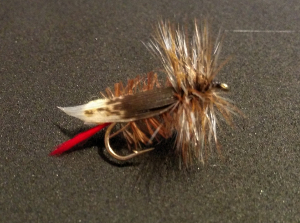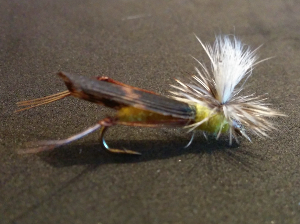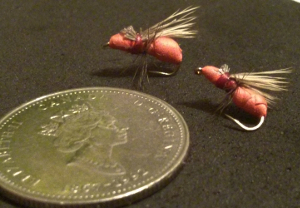
Terrestrials don’t always get the love they deserve. It’s true that caddisflies and mayflies are very important prey species for trout, and are often the right way to go with fly selection. What if there are no “hatches” happening the day you’re out though? Many terrestrials are active all year (except winter) and are on a trout’s menu for much of the year as well. There are actually some types of terrestrials that have “hatches” of their own, which rival even the largest mayfly hatches.
Grasshoppers

Grasshoppers are the “go-to” terrestrial pattern for many, and with good reason. A grasshopper looks like a big T-bone steak to a hungry trout, and is often irresistible. Grasshopper’s often fall off blades of grass overhanging the river bank into the water below. Grasshoppers can also fly, but many species are not that great at it, and are easily blown into the water on windy days. Hoppers come in a wide variety of sizes, and you can effectively fish hopper patterns from hook sizes 6 to 14. fish smaller sizes earlier in the summer, and larger sizes later in the summer as the grasshoppers mature.
Effective Patterns
- Joe’s Hopper
- Parachute Hopper
- Daves Hopper
The three patterns listed above have been very productive for me. Other patterns worth mentioning are Madam X and the wide variety of foam hoppers. I haven’t had much luck on these patterns, and prefer “buggier” patterns myself, but I know many other people that have great success with these.
Ants
Ants are present everywhere in the world, and are very active in the hot summer months. They very frequently get swept off of banks into a river while they are foraging for food. There is a large range of sizes of ants in North America, and ant patterns from a size 14 to a size 22 can be fished effectively, I tend to use a size 16-18 black foam ant most often.
Effective Patterns
I only really carry one ant pattern in all the sizes I need, and that is a black or red and black foam ant. I tie it slightly different than the video in the link above, as I wrap the foam around the hook shank rather than pulling it over an under body. There are other patterns that work (elk hair, dubbing, epoxy), but I haven’t really found trout have much of a preference for one over the other, and I quite like the added buoyancy the foam provides.
If you buy anything from the links below, i get some beer money!
Flying Ants

When ants breed, many queens and drones from many different colonies take flight all at once. It’s a “hatch” of sorts that rivals even the most impressive mayfly hatches. If you’ve ever been on the river when one of these mating flights is happening, you know that the trout are gorging themselves on these flying ants. In our area, there are the large black flying ants that you see around the house all the time, trout love these. The smaller red flying ants have much more impressive numbers in their mating flight, and these are the ones you really want to keep an eye out for. Often times in the fall I’ll notice a hatch of these red ants right around prime mackerel fishing season. At this point I pack up the mackerel gear and head upstream because I know the trout are in a feeding frenzy. A size 16 is about right for the flying red ants, and a size 8 is about right for the black ants.
Effective Patterns:
- Foam ant with elk hair wing.
- Elk hair caddis flies can work in a pinch if you don’t have any specific flying ant patterns.
I don’t really know if there’s a specific name for the foam winged ant pattern… but I just tie a normal foam ant and add an elk hair wing. Like I mentioned earlier, I tie the red foam ant on a size 16 hook, and a black foam and on a size 8 hook.
Crickets
Crickets are grasshoppers forgotten cousin. While they don’t fly around like hoppers, they still fall into the water often enough. Crickets are big and juicy and viewed much the same way hoppers are by trout. Fish cricket patterns in just a little bit smaller sizes than hoppers, sizes 10 through 16 are good choices.
Effective Patterns
Beetles
Beetles are the most varied group of insects in the world, and come in a wide range of colours and sizes. Most of the beetles around here are black and sizes 14 (June bugs!) to 22 or smaller.
Effective Patterns
Other terrestrial flies to try include cicada, sow bug, spider, butterfly and moth patterns.

“One of my favourite terrestrial pattern”
I do not agree
http://www.outdoorlife.com/blogs/gone-fishin/2014/06/fly-fishing-12-best-extra-terrestrials-flies-trout